Modern Construction Project: Research on Productivity and Contracts
VerifiedAdded on 2021/04/24
|7
|1714
|165
Report
AI Summary
This research paper provides an in-depth analysis of modern construction projects, focusing on labor productivity and its critical role in project success. The paper explores key subtopics such as achieving smarter, better, and cheaper construction methods; pre-construction and on-site effectiveness; the importance of peer benchmarks; modern construction contracts; and lifting pre-competitive innovation. It delves into factors influencing affordable housing, the impact of contractor involvement in the planning and design phase, and the role of technology in enhancing on-site management. The paper also examines the significance of peer benchmarking as a management tool, the essential requirements of modern construction contracts, and the role of innovation in shaping the industry. The research draws upon various sources to support its findings, offering a comprehensive overview of the challenges and opportunities in modern construction.
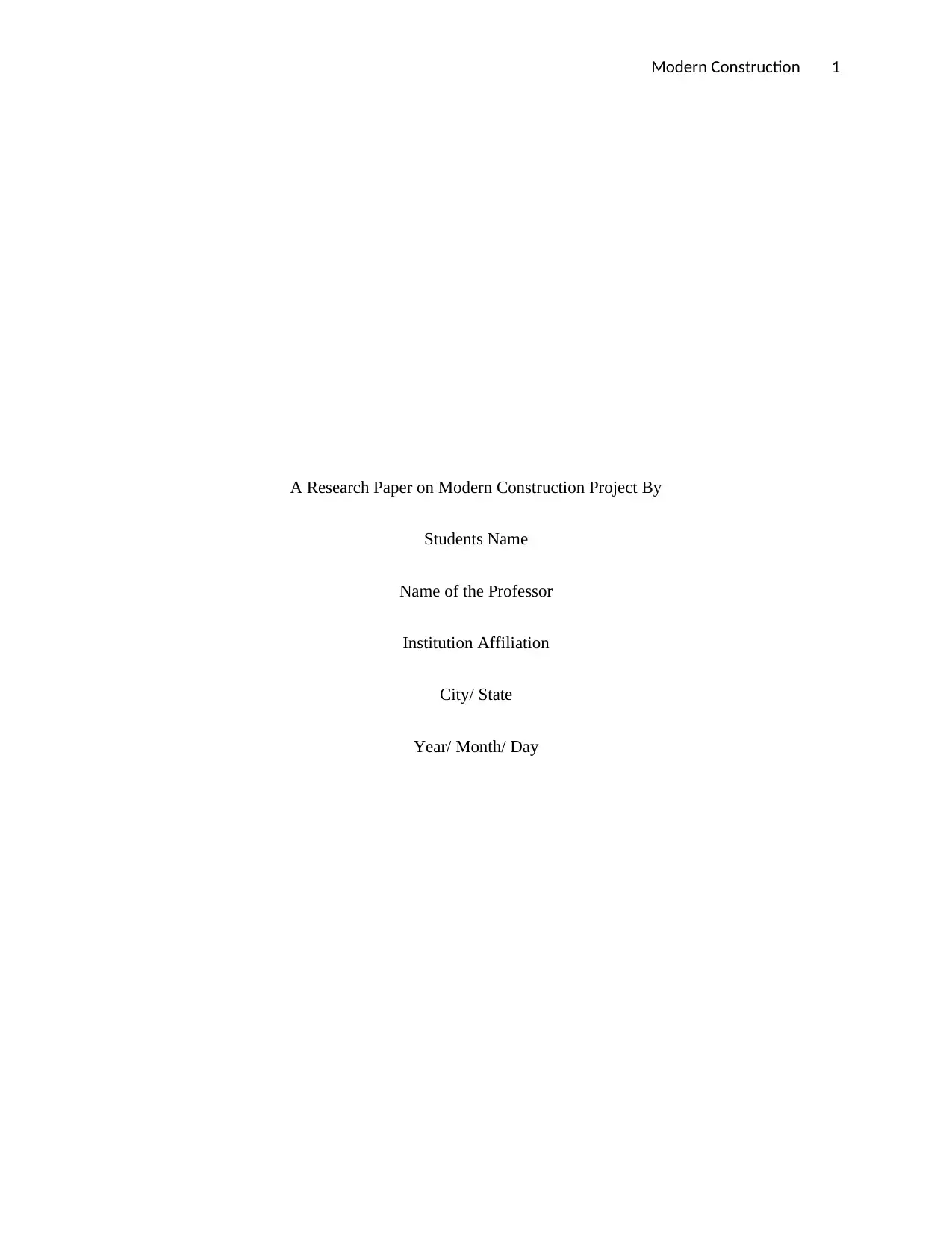
Modern Construction 1
A Research Paper on Modern Construction Project By
Students Name
Name of the Professor
Institution Affiliation
City/ State
Year/ Month/ Day
A Research Paper on Modern Construction Project By
Students Name
Name of the Professor
Institution Affiliation
City/ State
Year/ Month/ Day
Paraphrase This Document
Need a fresh take? Get an instant paraphrase of this document with our AI Paraphraser
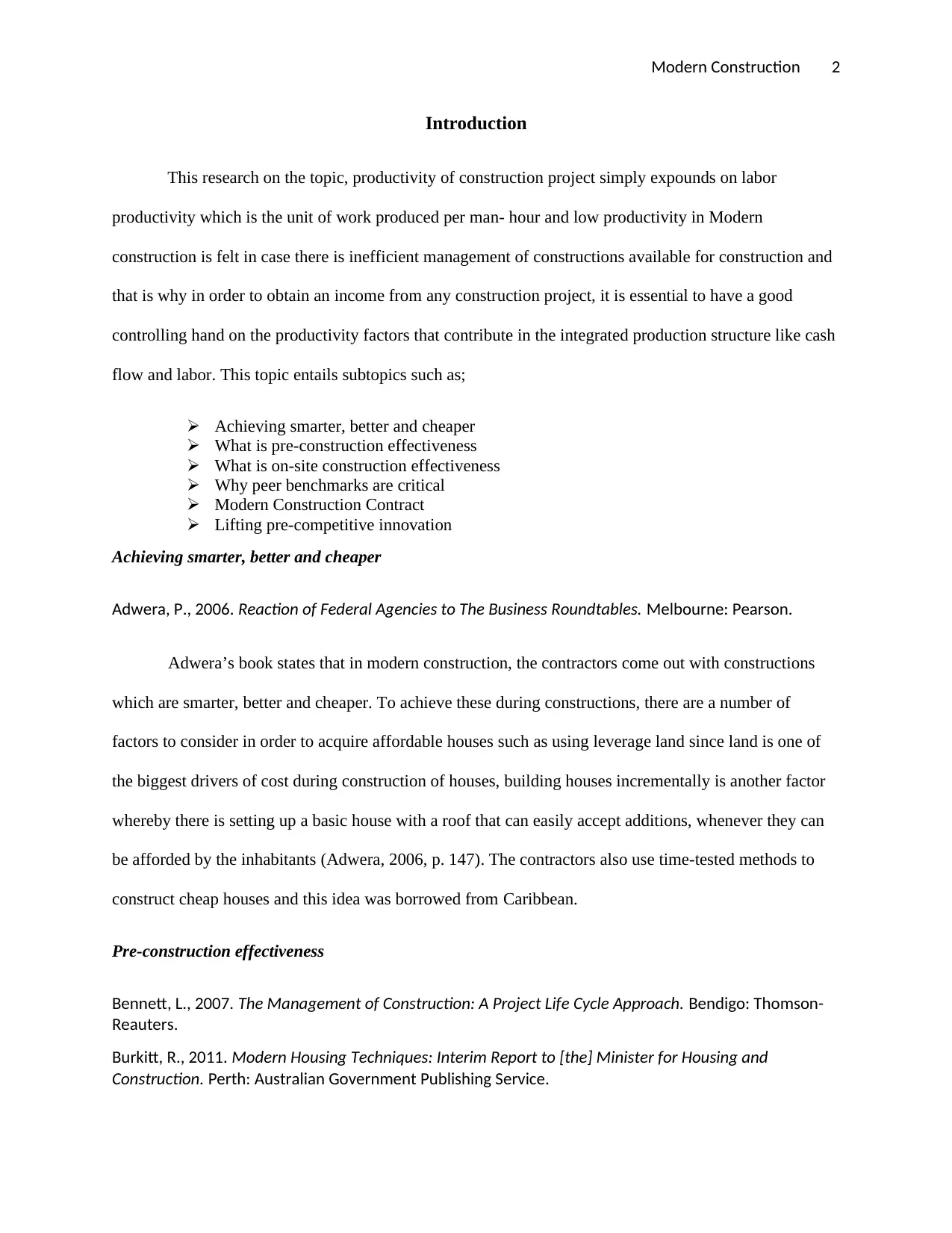
Modern Construction 2
Introduction
This research on the topic, productivity of construction project simply expounds on labor
productivity which is the unit of work produced per man- hour and low productivity in Modern
construction is felt in case there is inefficient management of constructions available for construction and
that is why in order to obtain an income from any construction project, it is essential to have a good
controlling hand on the productivity factors that contribute in the integrated production structure like cash
flow and labor. This topic entails subtopics such as;
Achieving smarter, better and cheaper
What is pre-construction effectiveness
What is on-site construction effectiveness
Why peer benchmarks are critical
Modern Construction Contract
Lifting pre-competitive innovation
Achieving smarter, better and cheaper
Adwera, P., 2006. Reaction of Federal Agencies to The Business Roundtables. Melbourne: Pearson.
Adwera’s book states that in modern construction, the contractors come out with constructions
which are smarter, better and cheaper. To achieve these during constructions, there are a number of
factors to consider in order to acquire affordable houses such as using leverage land since land is one of
the biggest drivers of cost during construction of houses, building houses incrementally is another factor
whereby there is setting up a basic house with a roof that can easily accept additions, whenever they can
be afforded by the inhabitants (Adwera, 2006, p. 147). The contractors also use time-tested methods to
construct cheap houses and this idea was borrowed from Caribbean.
Pre-construction effectiveness
Bennett, L., 2007. The Management of Construction: A Project Life Cycle Approach. Bendigo: Thomson-
Reauters.
Burkitt, R., 2011. Modern Housing Techniques: Interim Report to [the] Minister for Housing and
Construction. Perth: Australian Government Publishing Service.
Introduction
This research on the topic, productivity of construction project simply expounds on labor
productivity which is the unit of work produced per man- hour and low productivity in Modern
construction is felt in case there is inefficient management of constructions available for construction and
that is why in order to obtain an income from any construction project, it is essential to have a good
controlling hand on the productivity factors that contribute in the integrated production structure like cash
flow and labor. This topic entails subtopics such as;
Achieving smarter, better and cheaper
What is pre-construction effectiveness
What is on-site construction effectiveness
Why peer benchmarks are critical
Modern Construction Contract
Lifting pre-competitive innovation
Achieving smarter, better and cheaper
Adwera, P., 2006. Reaction of Federal Agencies to The Business Roundtables. Melbourne: Pearson.
Adwera’s book states that in modern construction, the contractors come out with constructions
which are smarter, better and cheaper. To achieve these during constructions, there are a number of
factors to consider in order to acquire affordable houses such as using leverage land since land is one of
the biggest drivers of cost during construction of houses, building houses incrementally is another factor
whereby there is setting up a basic house with a roof that can easily accept additions, whenever they can
be afforded by the inhabitants (Adwera, 2006, p. 147). The contractors also use time-tested methods to
construct cheap houses and this idea was borrowed from Caribbean.
Pre-construction effectiveness
Bennett, L., 2007. The Management of Construction: A Project Life Cycle Approach. Bendigo: Thomson-
Reauters.
Burkitt, R., 2011. Modern Housing Techniques: Interim Report to [the] Minister for Housing and
Construction. Perth: Australian Government Publishing Service.
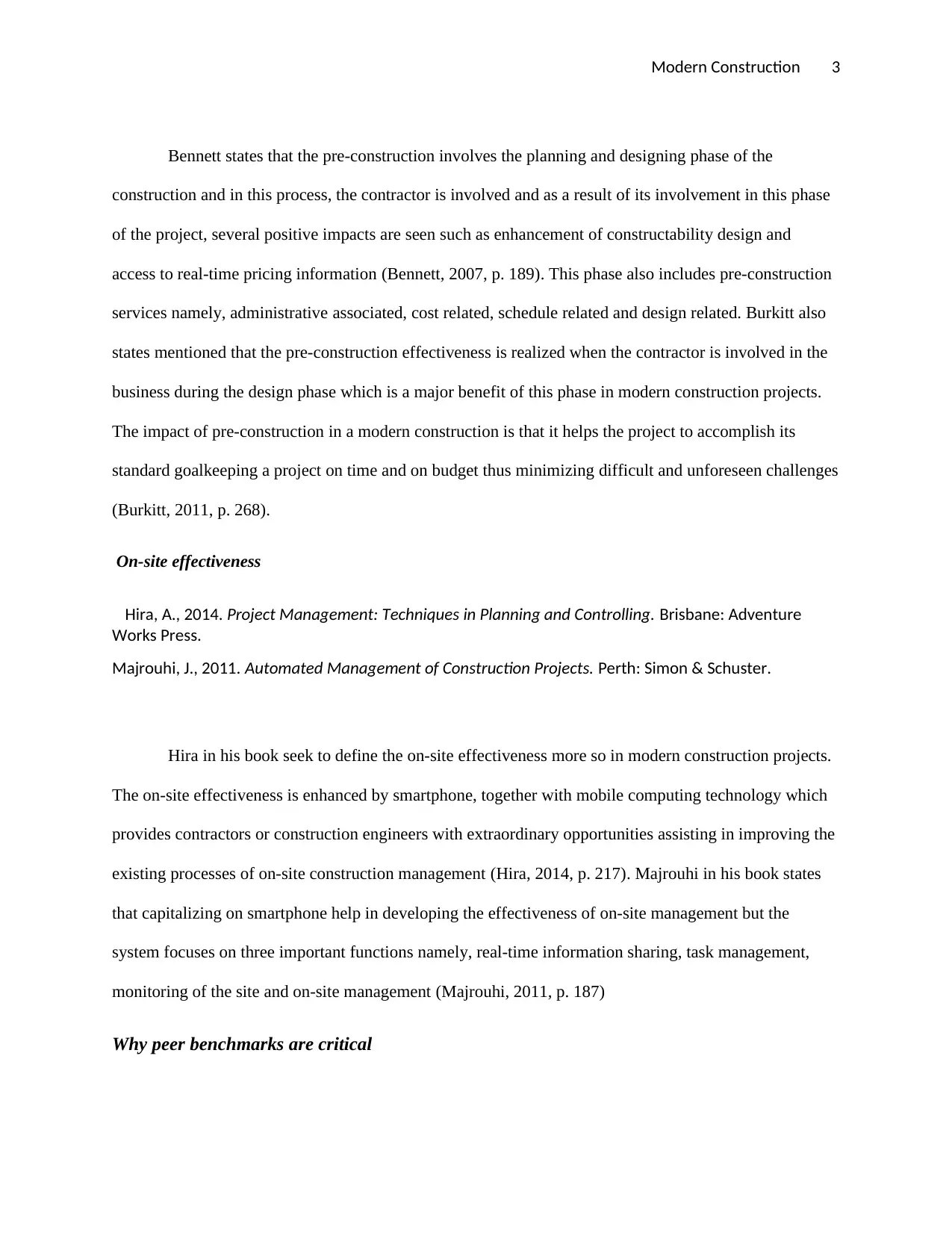
Modern Construction 3
Bennett states that the pre-construction involves the planning and designing phase of the
construction and in this process, the contractor is involved and as a result of its involvement in this phase
of the project, several positive impacts are seen such as enhancement of constructability design and
access to real-time pricing information (Bennett, 2007, p. 189). This phase also includes pre-construction
services namely, administrative associated, cost related, schedule related and design related. Burkitt also
states mentioned that the pre-construction effectiveness is realized when the contractor is involved in the
business during the design phase which is a major benefit of this phase in modern construction projects.
The impact of pre-construction in a modern construction is that it helps the project to accomplish its
standard goalkeeping a project on time and on budget thus minimizing difficult and unforeseen challenges
(Burkitt, 2011, p. 268).
On-site effectiveness
Hira, A., 2014. Project Management: Techniques in Planning and Controlling. Brisbane: Adventure
Works Press.
Majrouhi, J., 2011. Automated Management of Construction Projects. Perth: Simon & Schuster.
Hira in his book seek to define the on-site effectiveness more so in modern construction projects.
The on-site effectiveness is enhanced by smartphone, together with mobile computing technology which
provides contractors or construction engineers with extraordinary opportunities assisting in improving the
existing processes of on-site construction management (Hira, 2014, p. 217). Majrouhi in his book states
that capitalizing on smartphone help in developing the effectiveness of on-site management but the
system focuses on three important functions namely, real-time information sharing, task management,
monitoring of the site and on-site management (Majrouhi, 2011, p. 187)
Why peer benchmarks are critical
Bennett states that the pre-construction involves the planning and designing phase of the
construction and in this process, the contractor is involved and as a result of its involvement in this phase
of the project, several positive impacts are seen such as enhancement of constructability design and
access to real-time pricing information (Bennett, 2007, p. 189). This phase also includes pre-construction
services namely, administrative associated, cost related, schedule related and design related. Burkitt also
states mentioned that the pre-construction effectiveness is realized when the contractor is involved in the
business during the design phase which is a major benefit of this phase in modern construction projects.
The impact of pre-construction in a modern construction is that it helps the project to accomplish its
standard goalkeeping a project on time and on budget thus minimizing difficult and unforeseen challenges
(Burkitt, 2011, p. 268).
On-site effectiveness
Hira, A., 2014. Project Management: Techniques in Planning and Controlling. Brisbane: Adventure
Works Press.
Majrouhi, J., 2011. Automated Management of Construction Projects. Perth: Simon & Schuster.
Hira in his book seek to define the on-site effectiveness more so in modern construction projects.
The on-site effectiveness is enhanced by smartphone, together with mobile computing technology which
provides contractors or construction engineers with extraordinary opportunities assisting in improving the
existing processes of on-site construction management (Hira, 2014, p. 217). Majrouhi in his book states
that capitalizing on smartphone help in developing the effectiveness of on-site management but the
system focuses on three important functions namely, real-time information sharing, task management,
monitoring of the site and on-site management (Majrouhi, 2011, p. 187)
Why peer benchmarks are critical
⊘ This is a preview!⊘
Do you want full access?
Subscribe today to unlock all pages.

Trusted by 1+ million students worldwide
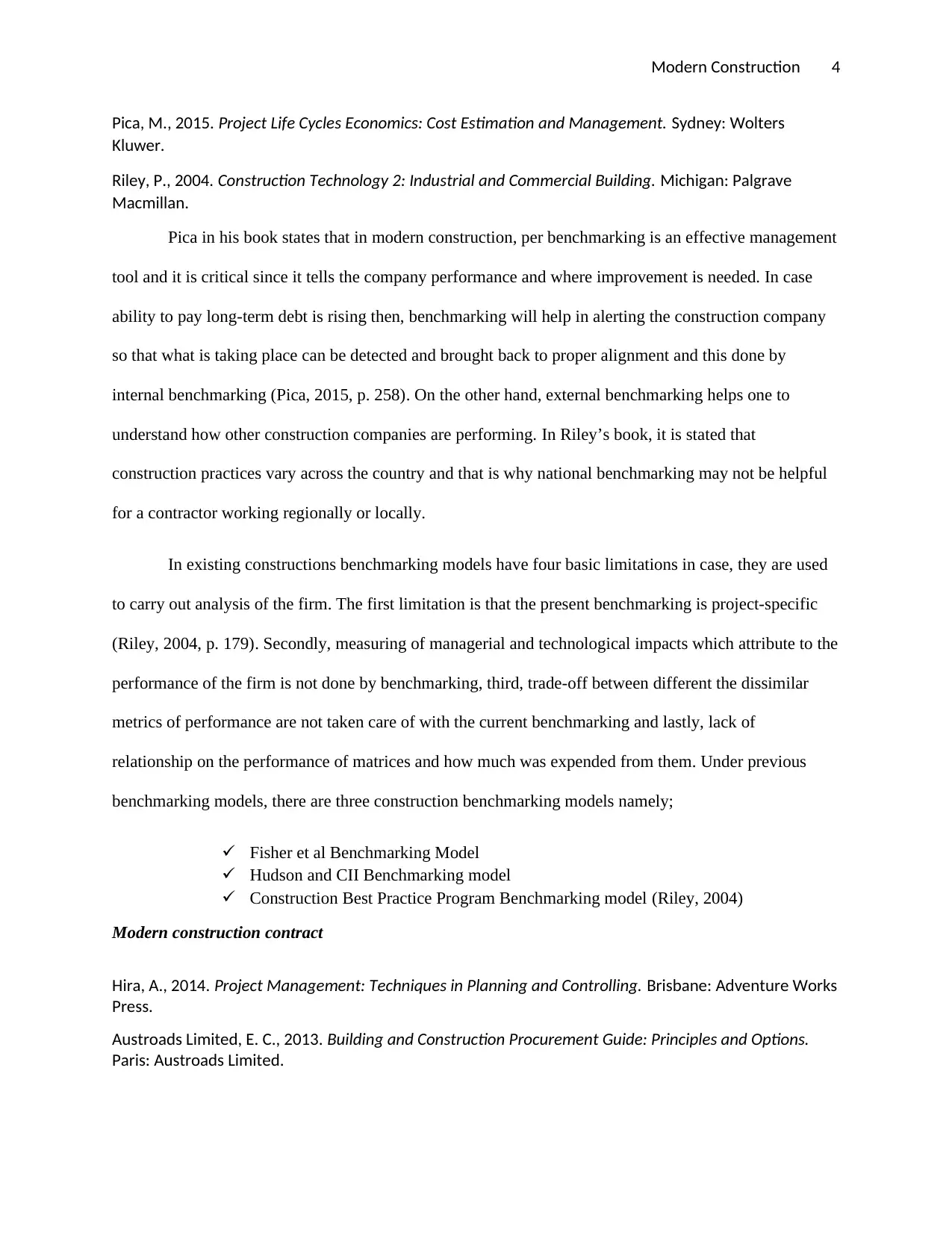
Modern Construction 4
Pica, M., 2015. Project Life Cycles Economics: Cost Estimation and Management. Sydney: Wolters
Kluwer.
Riley, P., 2004. Construction Technology 2: Industrial and Commercial Building. Michigan: Palgrave
Macmillan.
Pica in his book states that in modern construction, per benchmarking is an effective management
tool and it is critical since it tells the company performance and where improvement is needed. In case
ability to pay long-term debt is rising then, benchmarking will help in alerting the construction company
so that what is taking place can be detected and brought back to proper alignment and this done by
internal benchmarking (Pica, 2015, p. 258). On the other hand, external benchmarking helps one to
understand how other construction companies are performing. In Riley’s book, it is stated that
construction practices vary across the country and that is why national benchmarking may not be helpful
for a contractor working regionally or locally.
In existing constructions benchmarking models have four basic limitations in case, they are used
to carry out analysis of the firm. The first limitation is that the present benchmarking is project-specific
(Riley, 2004, p. 179). Secondly, measuring of managerial and technological impacts which attribute to the
performance of the firm is not done by benchmarking, third, trade-off between different the dissimilar
metrics of performance are not taken care of with the current benchmarking and lastly, lack of
relationship on the performance of matrices and how much was expended from them. Under previous
benchmarking models, there are three construction benchmarking models namely;
Fisher et al Benchmarking Model
Hudson and CII Benchmarking model
Construction Best Practice Program Benchmarking model (Riley, 2004)
Modern construction contract
Hira, A., 2014. Project Management: Techniques in Planning and Controlling. Brisbane: Adventure Works
Press.
Austroads Limited, E. C., 2013. Building and Construction Procurement Guide: Principles and Options.
Paris: Austroads Limited.
Pica, M., 2015. Project Life Cycles Economics: Cost Estimation and Management. Sydney: Wolters
Kluwer.
Riley, P., 2004. Construction Technology 2: Industrial and Commercial Building. Michigan: Palgrave
Macmillan.
Pica in his book states that in modern construction, per benchmarking is an effective management
tool and it is critical since it tells the company performance and where improvement is needed. In case
ability to pay long-term debt is rising then, benchmarking will help in alerting the construction company
so that what is taking place can be detected and brought back to proper alignment and this done by
internal benchmarking (Pica, 2015, p. 258). On the other hand, external benchmarking helps one to
understand how other construction companies are performing. In Riley’s book, it is stated that
construction practices vary across the country and that is why national benchmarking may not be helpful
for a contractor working regionally or locally.
In existing constructions benchmarking models have four basic limitations in case, they are used
to carry out analysis of the firm. The first limitation is that the present benchmarking is project-specific
(Riley, 2004, p. 179). Secondly, measuring of managerial and technological impacts which attribute to the
performance of the firm is not done by benchmarking, third, trade-off between different the dissimilar
metrics of performance are not taken care of with the current benchmarking and lastly, lack of
relationship on the performance of matrices and how much was expended from them. Under previous
benchmarking models, there are three construction benchmarking models namely;
Fisher et al Benchmarking Model
Hudson and CII Benchmarking model
Construction Best Practice Program Benchmarking model (Riley, 2004)
Modern construction contract
Hira, A., 2014. Project Management: Techniques in Planning and Controlling. Brisbane: Adventure Works
Press.
Austroads Limited, E. C., 2013. Building and Construction Procurement Guide: Principles and Options.
Paris: Austroads Limited.
Paraphrase This Document
Need a fresh take? Get an instant paraphrase of this document with our AI Paraphraser
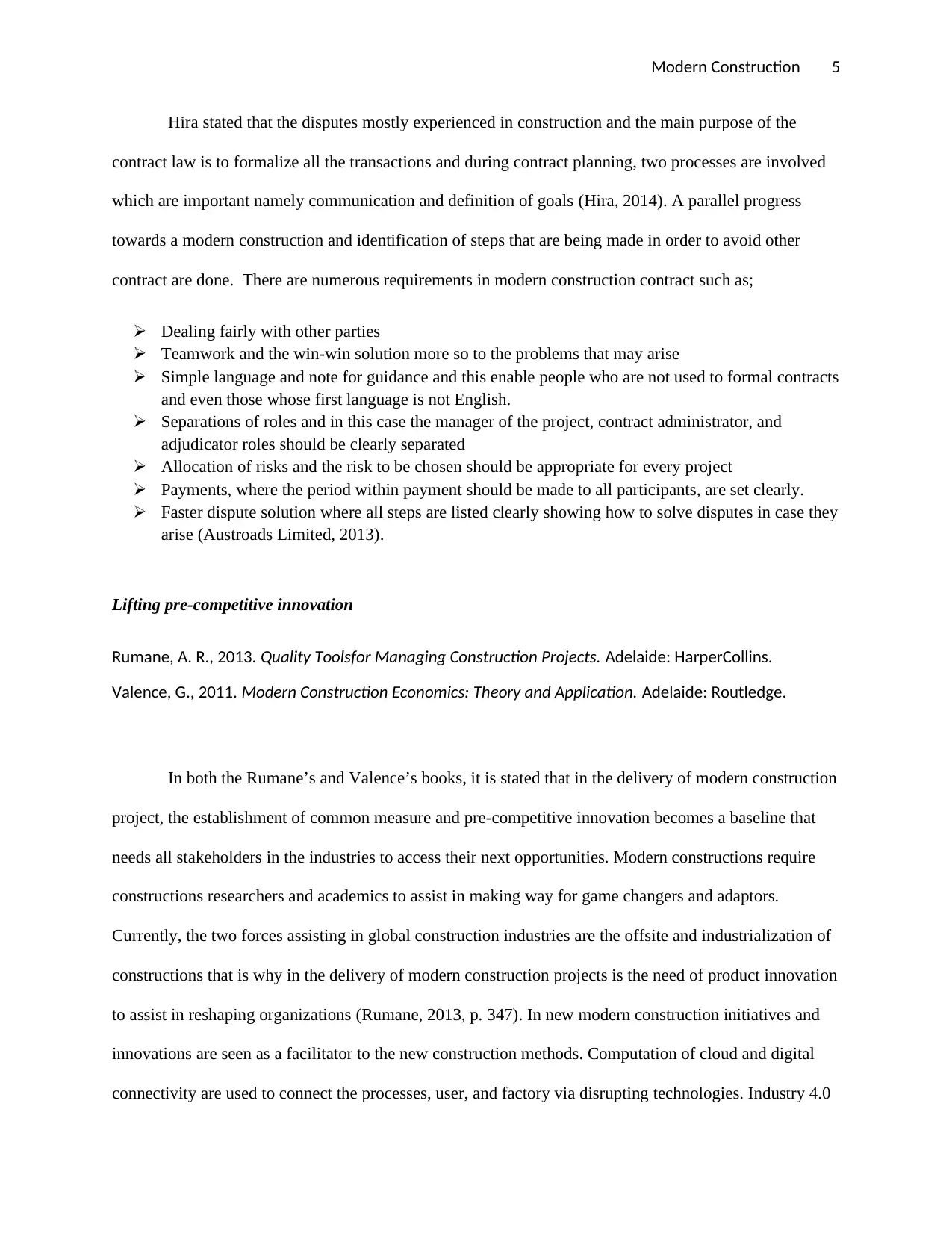
Modern Construction 5
Hira stated that the disputes mostly experienced in construction and the main purpose of the
contract law is to formalize all the transactions and during contract planning, two processes are involved
which are important namely communication and definition of goals (Hira, 2014). A parallel progress
towards a modern construction and identification of steps that are being made in order to avoid other
contract are done. There are numerous requirements in modern construction contract such as;
Dealing fairly with other parties
Teamwork and the win-win solution more so to the problems that may arise
Simple language and note for guidance and this enable people who are not used to formal contracts
and even those whose first language is not English.
Separations of roles and in this case the manager of the project, contract administrator, and
adjudicator roles should be clearly separated
Allocation of risks and the risk to be chosen should be appropriate for every project
Payments, where the period within payment should be made to all participants, are set clearly.
Faster dispute solution where all steps are listed clearly showing how to solve disputes in case they
arise (Austroads Limited, 2013).
Lifting pre-competitive innovation
Rumane, A. R., 2013. Quality Toolsfor Managing Construction Projects. Adelaide: HarperCollins.
Valence, G., 2011. Modern Construction Economics: Theory and Application. Adelaide: Routledge.
In both the Rumane’s and Valence’s books, it is stated that in the delivery of modern construction
project, the establishment of common measure and pre-competitive innovation becomes a baseline that
needs all stakeholders in the industries to access their next opportunities. Modern constructions require
constructions researchers and academics to assist in making way for game changers and adaptors.
Currently, the two forces assisting in global construction industries are the offsite and industrialization of
constructions that is why in the delivery of modern construction projects is the need of product innovation
to assist in reshaping organizations (Rumane, 2013, p. 347). In new modern construction initiatives and
innovations are seen as a facilitator to the new construction methods. Computation of cloud and digital
connectivity are used to connect the processes, user, and factory via disrupting technologies. Industry 4.0
Hira stated that the disputes mostly experienced in construction and the main purpose of the
contract law is to formalize all the transactions and during contract planning, two processes are involved
which are important namely communication and definition of goals (Hira, 2014). A parallel progress
towards a modern construction and identification of steps that are being made in order to avoid other
contract are done. There are numerous requirements in modern construction contract such as;
Dealing fairly with other parties
Teamwork and the win-win solution more so to the problems that may arise
Simple language and note for guidance and this enable people who are not used to formal contracts
and even those whose first language is not English.
Separations of roles and in this case the manager of the project, contract administrator, and
adjudicator roles should be clearly separated
Allocation of risks and the risk to be chosen should be appropriate for every project
Payments, where the period within payment should be made to all participants, are set clearly.
Faster dispute solution where all steps are listed clearly showing how to solve disputes in case they
arise (Austroads Limited, 2013).
Lifting pre-competitive innovation
Rumane, A. R., 2013. Quality Toolsfor Managing Construction Projects. Adelaide: HarperCollins.
Valence, G., 2011. Modern Construction Economics: Theory and Application. Adelaide: Routledge.
In both the Rumane’s and Valence’s books, it is stated that in the delivery of modern construction
project, the establishment of common measure and pre-competitive innovation becomes a baseline that
needs all stakeholders in the industries to access their next opportunities. Modern constructions require
constructions researchers and academics to assist in making way for game changers and adaptors.
Currently, the two forces assisting in global construction industries are the offsite and industrialization of
constructions that is why in the delivery of modern construction projects is the need of product innovation
to assist in reshaping organizations (Rumane, 2013, p. 347). In new modern construction initiatives and
innovations are seen as a facilitator to the new construction methods. Computation of cloud and digital
connectivity are used to connect the processes, user, and factory via disrupting technologies. Industry 4.0

Modern Construction 6
concept permits the contractors with better information which will assist them in planning, building, and
maintaining of buildings efficiently (Valence, 2011, p. 217).
concept permits the contractors with better information which will assist them in planning, building, and
maintaining of buildings efficiently (Valence, 2011, p. 217).
⊘ This is a preview!⊘
Do you want full access?
Subscribe today to unlock all pages.

Trusted by 1+ million students worldwide
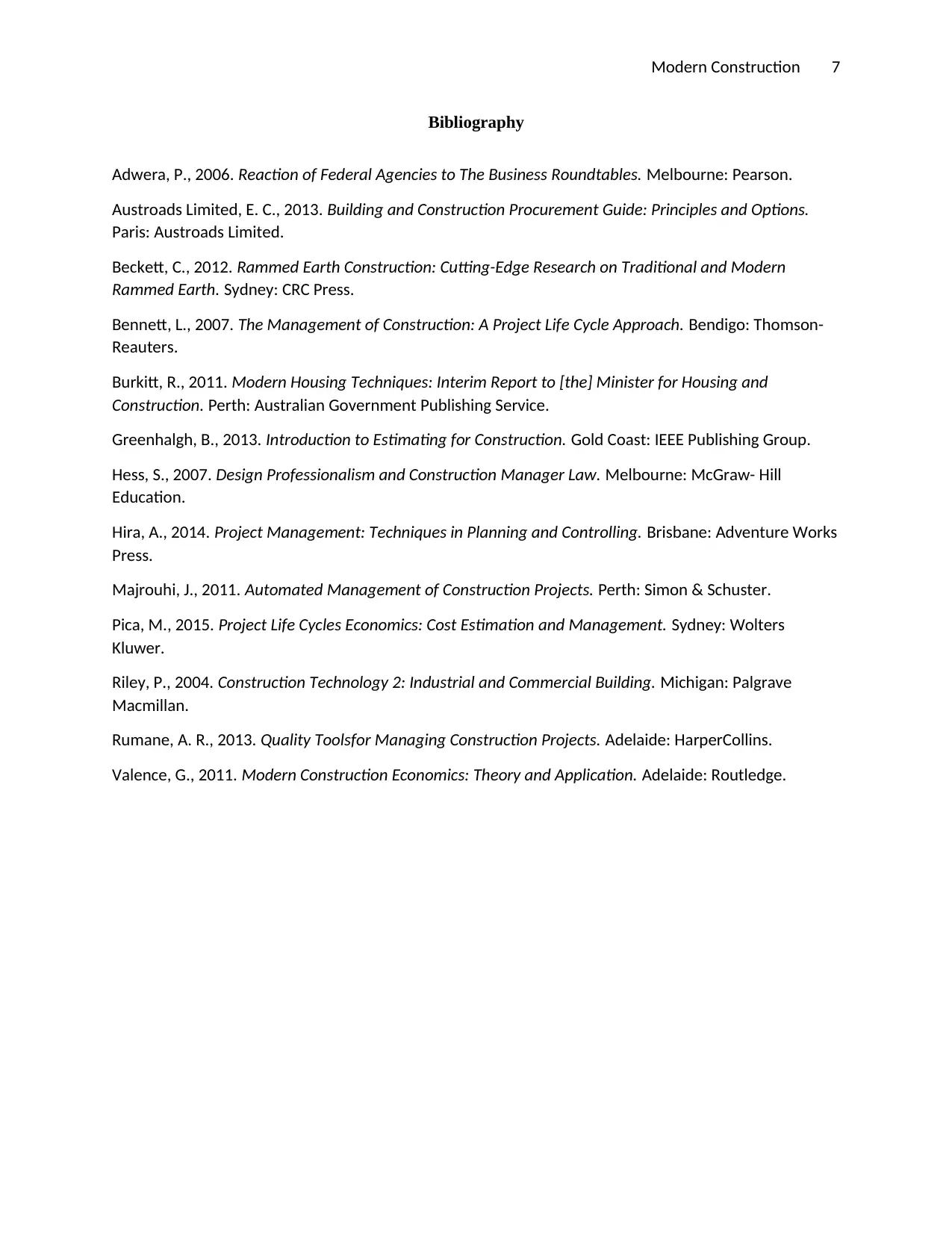
Modern Construction 7
Bibliography
Adwera, P., 2006. Reaction of Federal Agencies to The Business Roundtables. Melbourne: Pearson.
Austroads Limited, E. C., 2013. Building and Construction Procurement Guide: Principles and Options.
Paris: Austroads Limited.
Beckett, C., 2012. Rammed Earth Construction: Cutting-Edge Research on Traditional and Modern
Rammed Earth. Sydney: CRC Press.
Bennett, L., 2007. The Management of Construction: A Project Life Cycle Approach. Bendigo: Thomson-
Reauters.
Burkitt, R., 2011. Modern Housing Techniques: Interim Report to [the] Minister for Housing and
Construction. Perth: Australian Government Publishing Service.
Greenhalgh, B., 2013. Introduction to Estimating for Construction. Gold Coast: IEEE Publishing Group.
Hess, S., 2007. Design Professionalism and Construction Manager Law. Melbourne: McGraw- Hill
Education.
Hira, A., 2014. Project Management: Techniques in Planning and Controlling. Brisbane: Adventure Works
Press.
Majrouhi, J., 2011. Automated Management of Construction Projects. Perth: Simon & Schuster.
Pica, M., 2015. Project Life Cycles Economics: Cost Estimation and Management. Sydney: Wolters
Kluwer.
Riley, P., 2004. Construction Technology 2: Industrial and Commercial Building. Michigan: Palgrave
Macmillan.
Rumane, A. R., 2013. Quality Toolsfor Managing Construction Projects. Adelaide: HarperCollins.
Valence, G., 2011. Modern Construction Economics: Theory and Application. Adelaide: Routledge.
Bibliography
Adwera, P., 2006. Reaction of Federal Agencies to The Business Roundtables. Melbourne: Pearson.
Austroads Limited, E. C., 2013. Building and Construction Procurement Guide: Principles and Options.
Paris: Austroads Limited.
Beckett, C., 2012. Rammed Earth Construction: Cutting-Edge Research on Traditional and Modern
Rammed Earth. Sydney: CRC Press.
Bennett, L., 2007. The Management of Construction: A Project Life Cycle Approach. Bendigo: Thomson-
Reauters.
Burkitt, R., 2011. Modern Housing Techniques: Interim Report to [the] Minister for Housing and
Construction. Perth: Australian Government Publishing Service.
Greenhalgh, B., 2013. Introduction to Estimating for Construction. Gold Coast: IEEE Publishing Group.
Hess, S., 2007. Design Professionalism and Construction Manager Law. Melbourne: McGraw- Hill
Education.
Hira, A., 2014. Project Management: Techniques in Planning and Controlling. Brisbane: Adventure Works
Press.
Majrouhi, J., 2011. Automated Management of Construction Projects. Perth: Simon & Schuster.
Pica, M., 2015. Project Life Cycles Economics: Cost Estimation and Management. Sydney: Wolters
Kluwer.
Riley, P., 2004. Construction Technology 2: Industrial and Commercial Building. Michigan: Palgrave
Macmillan.
Rumane, A. R., 2013. Quality Toolsfor Managing Construction Projects. Adelaide: HarperCollins.
Valence, G., 2011. Modern Construction Economics: Theory and Application. Adelaide: Routledge.
1 out of 7
Your All-in-One AI-Powered Toolkit for Academic Success.
+13062052269
info@desklib.com
Available 24*7 on WhatsApp / Email
![[object Object]](/_next/static/media/star-bottom.7253800d.svg)
Unlock your academic potential
Copyright © 2020–2025 A2Z Services. All Rights Reserved. Developed and managed by ZUCOL.
